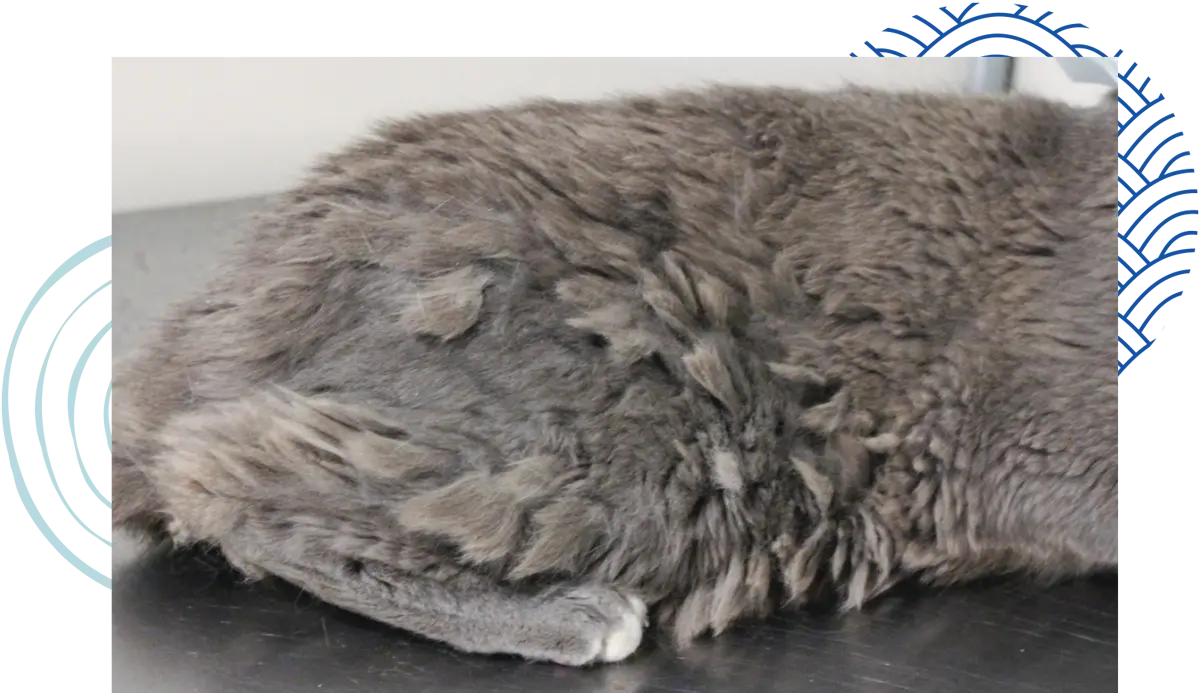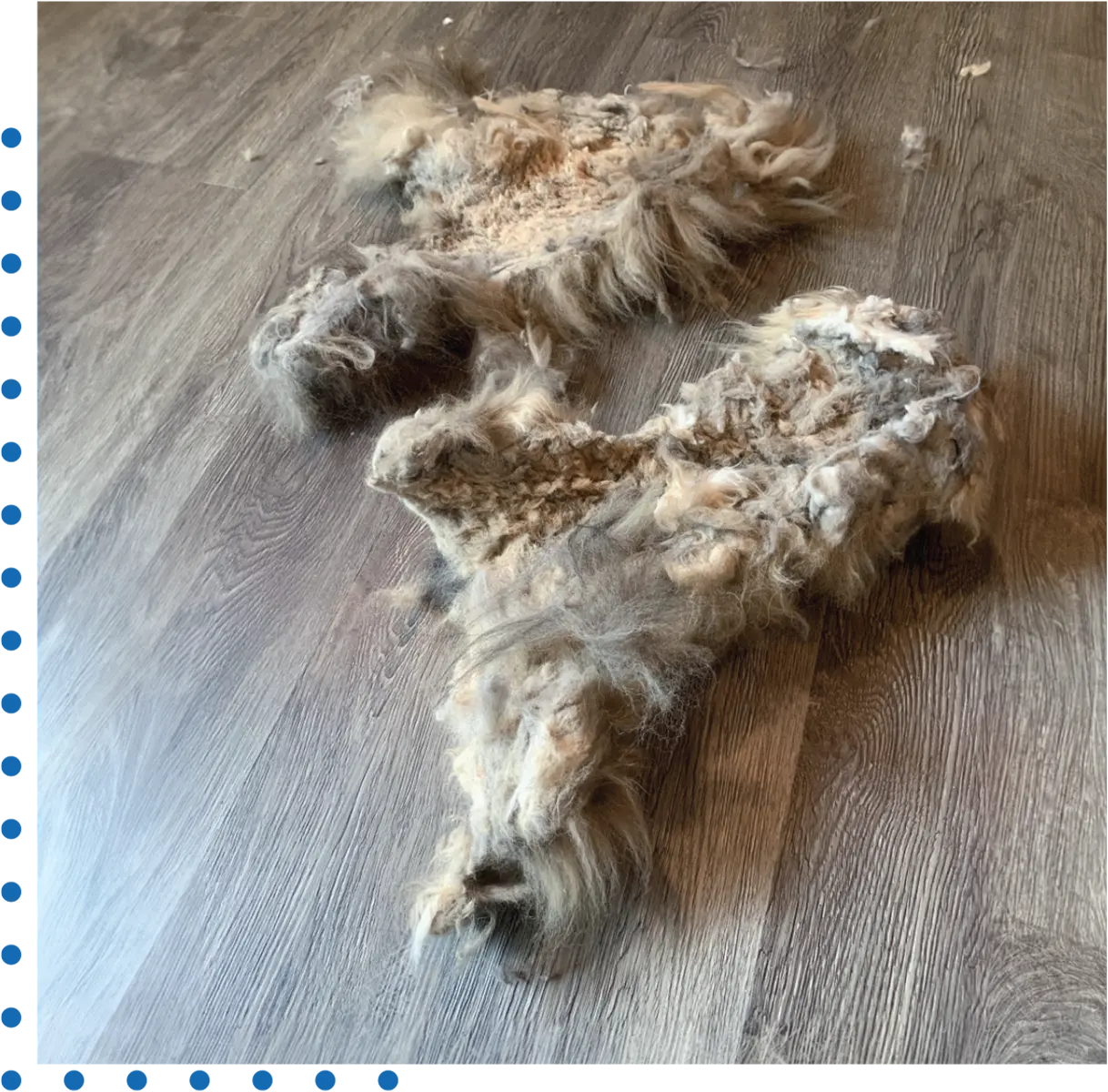
Photos provided by Lynn Paolillo
 ll too often in my grooming salon, first-time appointments are made when a cat is matted. Their hair has become thick, dull and oily, with large clumps all over. Most of the time, the owner is at a complete loss as to how they got matted in the first place. Was there a health change? Did they just stop grooming themselves? Did they rub around on the carpet? What was it that caused their cat to mat? This article will cover how cats become matted, which cats are at the highest risk for developing mats and what the options are to remove them.
ll too often in my grooming salon, first-time appointments are made when a cat is matted. Their hair has become thick, dull and oily, with large clumps all over. Most of the time, the owner is at a complete loss as to how they got matted in the first place. Was there a health change? Did they just stop grooming themselves? Did they rub around on the carpet? What was it that caused their cat to mat? This article will cover how cats become matted, which cats are at the highest risk for developing mats and what the options are to remove them.

All cats—even short-haired cats—are at risk of developing knots, tangles and mats.
Over time, more and more dead hair sticks together with excess oils from the cat’s skin. Small clumps turn into large clumps, and large clumps spread and grow into more severe matting. Once matting has formed, there are only two options: it either gets combed out or shaved out. Cats aren’t equipped to remove matting on their own and it will only get worse and more painful.
It may seem that only long-haired or very fluffy cats are susceptible to getting matted, but actually all cats—even short-haired cats—are at risk of developing knots, tangles and mats. Since it is dead hair compacting together, this can happen with hair at any length. For long-haired cats, the highest areas of risk for matting are the belly, armpits, sanitary area, chest, neck, base of the tail, back, sides and fluffy tails.
Now, I know what you’re thinking—um, that’s pretty much the whole cat. Well, welcome to owning a long-haired cat, for which, unfortunately, matting can be very common. It starts with small clumps of hair, especially in areas like the armpits, belly, sanitary regions and rear legs, then they get bigger and bigger and cover more areas until the only thing left to do is to shave and start over.
When trying to prevent matting on a long-haired cat, it helps to start on the “high-friction areas;” namely, the areas that can rub together when the cat moves, rolls around on the carpet, etc. So this includes the underside (belly, armpits, sanitary), the backs of the rear legs and chest.
When a short-haired cat develops mats, it isn’t caused by tangles. It is clumps of dead hair. But since it consists of lumps of dead hair latched onto the live hairs and skin, it can’t be brushed out. It either gets combed out (possibly causing discomfort for the cat and leaving a bald spot behind) or shaved out by a professional.
Larger areas of matting often require shaving for the cat’s comfort.


- Size of the matting/clumps. Mats that are the size of a nickel or smaller have a higher chance of being combed out safely and without causing pain or irritation to the skin. Larger areas of matting often require shaving for the cat’s comfort.
- Location on the cat’s body. The skin of the belly, armpits, and sanitary area are very delicate and more sensitive to combing and tugging at the hair. Oftentimes shaving may be the better option.
- Age and skin condition. Older cats or cats with health issues have limited options when it comes to mat removal. Their skin can be thin and wrinkly or their limbs stiff and arthritic, making them more prone to injury or discomfort during grooming.
- Cat’s temperament: Patient, easy-going cats can often tolerate the additional time combing out mats requires. But cats that are sensitive to touch, easily aggravated or not used to being handled add additional challenges to any mat removal, even small or limited areas. For these cats, you will need to evaluate on a case-by-case basis, and they may be referred to a veterinarian for medication options if needed.
The bottom line is that almost every type of cat can become matted. Clumps, knots and tangles do not discriminate; young, old, thin, large, healthy and cats with health issues can all develop mats for different reasons. The best way to prevent matting is a regular grooming schedule that includes a bath, blow-dry and comb-out. Haircuts like lion cuts or teddy bear haircuts can also be an option for some cats to prevent their coats from becoming matted.
